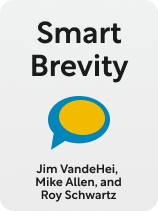

This article is an excerpt from the Shortform book guide to "Smart Brevity" by Jim VandeHei, Mike Allen, and Roy Schwartz. Shortform has the world's best summaries and analyses of books you should be reading.
Like this article? Sign up for a free trial here.
Do long-winded emails and unproductive meetings feature in your work life? What if you could infuse your organization with brevity?
Concise communication is a valuable skill in today’s fast-paced business world. In Smart Brevity, authors Jim VandeHei, Mike Allen, and Roy Schwartz offer practical tips for streamlining emails, running efficient meetings, and fostering a culture of clear messaging.
Keep reading to discover how brevity can boost productivity and engagement across your organization.
Concise Communication in the Workplace
Brief, impactful messaging can improve workplace communication in several ways, such as by strengthening emails and streamlining meetings. Concise communication as a part of workplace culture benefits the organization in several ways.
Email is now the primary avenue for most of our business communications. The authors insist that all their writing techniques should apply—craft clear email subject lines, state your main point up front, provide context, and format your text for easy skimming. This can help reduce inbox clutter and ensure that you convey important information. This is true for person-to-person emails as well as companywide messages. For the latter, employing a standard newsletter format based on principles of clarity and brevity allows you to better articulate company values and corporate strategies, as well as to pass along progress updates. After all, employees appreciate succinct communications rather than lengthy memos.
(Shortform note: Though email is the primary form of written communication that businesses use, it may not be the best for every situation. Email lacks real-time feedback loops, which can slow communication and drain productivity. Information in email threads can easily get lost, hindering the flow of ideas. The alternatives include project management software, collaborative platforms, company intranets, and instant messaging, all of which come with their own pros and cons. Most email alternatives offer collaborative features and real-time interaction that standard email doesn’t, but many lack the formatting tools that Smart Brevity’s authors suggest you employ to make your key points stand out.)
VandeHei, Allen, and Schwartz argue that the same precepts that make writing stronger can also make meetings more effective. First, you should establish a clear purpose beforehand, constituting your meeting’s “strong opening statement.” Like writing, your meetings should be as brief as possible, so enforce time limits, which can be less than half an hour—once again overturning the assumption that length equals depth. Use concise writing principles in your presentations to convey your ideas memorably, as well as minimal text and strong visual storytelling. Finally, be sure to summarize each meeting’s key takeaways and action items, just as you would use bullet points in a document to highlight what’s important.
(Shortform note: While VandeHei, Allen, and Schwartz apply the principles of strong writing to business meetings and presentations, the majority of communication in those settings is spoken, not written. In Simply Said, Jay Sullivan fills this gap by offering tips for strong oral communication—be mindful of the speed and volume at which you talk, make eye contact with the people you’re speaking to, use open body language, and devote energy to listening in addition to talking. When combined with the rules for strong writing, effective speaking skills can make for powerful presentations and meetings.)
Brevity and Organizational Culture
What’s good for one is good for all. VandeHei, Allen, and Schwartz assert that any business or organization that makes strong, clear communication a part of its culture will reap many benefits. These include keeping everyone onboard with the organization’s mission, increasing productivity, and opening the door to a diversity of perspectives.
To begin with, the authors state that, by communicating regularly and concisely, organizations can ensure that all employees and divisions are aligned with the company’s goals and priorities. Especially when executives share weekly updates using principles of effective communication, they can let everyone in the company understand what people outside their groups are working on, thereby eliminating organizational silos.This can combat workers’ feelings of being left out of the company loop, particularly for those who work from home some or all of the time. By communicating clearly and regularly, organizations can keep workers engaged with the company’s mission and purpose.
(Shortform note: While VandeHei, Allen, and Schwartz list goal alignment as one of the benefits of clear communication, in Empowered, Marty Cagan and Chris Jones go further and list defining and articulating an overarching goal as the first thing a leader must do. If crafted well, a strongly worded goal has a powerful impact on team performance—it motivates team members and gives them a framework to decide for themselves how to achieve their mission. But be careful not to frame your goals so concisely that they read as a to-do-list. Instead, Cagan and Jones recommend shaping them into a compelling vision that every team member can connect with.)
It almost goes without saying that encouraging brevity and clarity in messaging will increase an organization’s efficiency. Striving to communicate in a way that saves time and eliminates unnecessary static can save countless hours of wasted employee time and thereby increase productivity. To implement strong communication practices companywide, the authors recommend using a system of scoring and feedback to improve employees’ writing and communication skills over time. Therefore, organizations that embrace these practices also adopt a culture of continuous learning and improvement.
(Shortform note: While the authors’ advice for staff training provides a starting place, there are additional steps you can take to improve your staff’s writing skills. You can begin by assessing their current abilities and identifying key issues, such as clarity, language use, and readability. Then you can implement various strategies, such as providing access to proofreading tools, hiring a writing expert to be in charge of training, and modeling strong writing yourself. Above all, remember that training is most successful when you offer specific and constructive feedback that begins by focusing on each team member’s strengths.)
For maximum effect, VandeHei, Allen, and Schwartz suggest that clear communication must go both ways—up and down the company ladder. A company that values strong communication should be transparent. When an organization encourages open, honest messaging at every level, it opens itself up to viewpoints from people with diverse backgrounds, abilities, and experiences. Brevity and clarity in communication lets every stakeholder, from the bottom to the top, ensure their voice is heard.
(Shortform note: Though its focus is on improving your personal communication skills, Smart Brevity’s rules for writing never imply that communication is strictly top-to-bottom. In Radical Candor, Kim Scott expands on this and lists ways in which two-way communication fuels collaboration and productivity. By scheduling time for one-on-one sessions, all-hands meetings, and specific sessions for reflection and debate, a company makes its inner workings transparent, allowing for faster and smoother problem-solving. However, given the sheer number of meetings that take place in any organization, Smart Brevity’s principles can save everybody’s time if everyone is trained in their use.)
Exercise: Are You Clear and Concise?
VandeHei, Allen, and Schwartz argue that since the digital age has changed how people read, we all have to adapt and change the way we write—especially if we want other people to pay attention to what we write about. The authors recommend using a strong, active voice to write clear opening statements and brief explanations about why your message matters. Think about your professional style of writing and whether it conforms to Smart Brevity’s principles.
- Think back to the last email or report that you wrote to explain something important. How long was the message? Did you start by stating your key point, or was it buried deep in the document? What could you have done to make it shorter?
- In that message, how clear were you about the context that made your point meaningful? Do you believe your recipient fully understood what you were trying to convey, or do you think they missed the bigger picture, and why?
- List the media you use to communicate important information (emails, memos, or tweets, for example). In which of these can you see yourself applying Smart Brevity’s guidelines? Are there any in which the author’s principles might not apply, and if so, why?

———End of Preview———
Like what you just read? Read the rest of the world's best book summary and analysis of Jim VandeHei, Mike Allen, and Roy Schwartz's "Smart Brevity" at Shortform.
Here's what you'll find in our full Smart Brevity summary:
- How to cut straight to the point to make content engaging
- How clear communication can strengthen your organization
- Why technology has made long-form writing uninteresting






